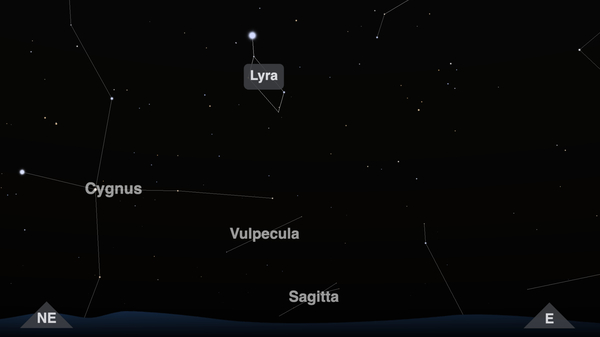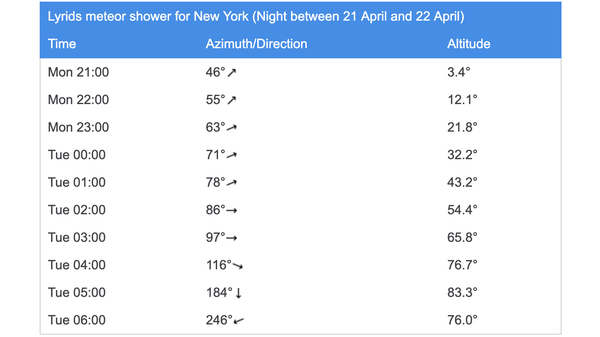Lyrids 2025: A Good Chance to See a Meteor!
The bright Moon won’t interfere much with this year’s Lyrids—it won’t rise until a few hours before dawn.


Lyrid meteors can appear in any part of the sky but appear to come from the direction of the constellation Lyra—seen here on our Night Sky Map for New York at midnight on April 21–22.
©timeanddate.com
How the Moon Affects Meteor Showers
The Lyrid meteor shower, which peaks every year around April 22, is generally not one of the biggest. At its peak, it produces up to 18 meteors per hour—fewer than, say, the 60–100 meteors per hour produced by the Perseid meteor shower in August.
Go to our Interactive Meteor Shower Sky MapIn 2025, the Lyrids will be helped a little bit by a Waning Crescent Moon that won’t rise until a few hours before dawn.
For meteor showers, the Moon is at its most helpful when it’s not there! The Moon is the brightest object in the night sky—its glare lights up the darkness and hides fainter meteors.
How to see meteor showersMeteors Versus the Moon
In terms of the Moon’s brightness, the Lyrids is one of the better meteor showers coming up in 2025.
The following table lists nine of the major meteor showers during the year. The second column gives the approximate peak dates of the shower. The dates are in UTC, as they can vary depending on your time zone.
The third column gives the Moon’s illumination at midnight on the peak night (again, in UTC). A dazzling Full Moon is 100% illuminated; an invisible New Moon is 0% illuminated.
Moon phase calendarMoon Illumination Around Meteor Shower Peaks, 2025
| Shower | Peak (Approx) | Moon Illumination |
|---|---|---|
| Quadrantids | Jan 3–4 | 19% |
| Lyrids | Apr 22–23 | 30% |
| Eta Aquarids | May 5–6 | 64% |
| Perseids | Aug 12–13 | 84% |
| Draconids | Oct 8–9 | 95% |
| Orionids | Oct 21–22 | 0% |
| Leonids | Nov 17–18 | 5% |
| Geminids | Dec 13–14 | 30% |
| Ursids | Dec 22–23 | 8% |
The Moon Helps a Bit...
The illumination figure in the above table also gives us an idea of how long the Moon will be above the horizon during the night. A Full Moon rises around sunset, and sets around sunrise—in other words, it shines brightly for the whole night. On the other hand, a New Moon rises and sets around the same time as the Sun.
For this year’s Lyrids, the Moon will be a roughly 30%-illuminated Waning Crescent Moon. This means it will be below the horizon for most of the night, and will rise a few hours before daybreak.
Moonrise and moonset in your location...But It’s Not Perfect
Having said that, the Moon’s timing could be better. This is because the hours before dawn are normally the best time of the night to observe the Lyrids.
Why? The streaks of light we see during a meteor shower can be traced back to a small area of the sky known as the radiant. In the case of the Lyrids, the radiant is close to the constellation Lyra.
We don’t need to know where the radiant is to enjoy a meteor shower—the meteors can appear in any part of the sky.
But it is helpful to know how high the radiant is above the horizon. Our meteor shower pages show the altitude of the radiant over the course of the night, from 0° (on the horizon) to 90° (directly overhead). The higher the altitude, the more meteors we are likely to see.
This is our table for New York on the peak night. We can see that the radiant is highest in the hours before dawn—alas, around the time the Moon rises up into the sky.


The radiant of the Lyrid meteor shower climbs higher into the sky over the course of the night.
©timeanddate.com
What’s Next?
The Lyrids are followed by the Eta Aquarid meteor shower, which peaks around May 5.
For the Eta Aquarids, the Moon will be a bigger and brighter Waxing Gibbous Moon. However, the Moon will set after midnight, leaving the pre-dawn sky dark and moonless.
Also, whereas the Lyrids favor observers in the Northern Hemisphere, the Eta Aquarids is a good meteor shower for both the Northern and Southern Hemispheres.